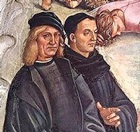
Luca Signorelli and Fra Angelico (depicted on the right)
Detail from the End of Days (1500-4) Luca Signorelli,
Cappella Nuova, Duomo, Orvieto
Guido di Pietro became Fra Giovanni da Fiesole (more commonly known as Fra Angelico) in ca. 1423, when he took vows in the Dominican convent at Fiesole, outside Florence. He moved to the convent of San Marco, Florence in 1436. Many of his works survive there.
He began work on the Cappella Nuova of the Duomo, Orvieto in 1447 (see below). However, his involvement in this project ended when Pope Nicholas V called him to Rome to paint the frescoes (1448-9) in what became known as the Cappella Niccolina of the Vatican. He died in Rome in 1455.
Orvieto
Vault of Cappella Nuova, Duomo (1447)
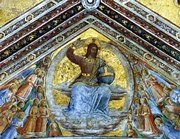
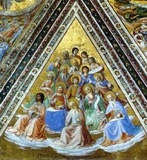
Christ in Judgment Prophets
The brothers Gentile and Arrigo Monaldeschi della Vipera, who ruled Orvieto in the period 1435-49, probably sponsored the initial phase of the decoration of the the Cappella Nuova of the Duomo. The Opera del Duomo consulted Francesco Baroni, who was was working on the stained glass of the Duomo in 1446, and he recommended Fra Angelico. The Opera del Duomo duly negotiated a contract in which Fra. Angelico agreed to spend three months in each summer of 1447-9 in Orvieto. The contract described him as ‘famosus ultra omnes pictores italicos’ (more famous than any other artist in Italy). Fra Angelico was consulted about the subject matter, and he suggested the Last Judgement.
Fra. Angelico arrived in Orvieto in June 1447, together with his assistant Benozzo Gozzoli and two apprentices: Giovanni Antonio da Firenze and Giacomo de Poli. The Opera del Duomo put the local painter Pietro di Nicola Baroni at his disposal. Fra Angelico and his team frescoed two of the four sections of the vault nearest the altar, which depicted:
-
✴Christ in Judgment; and
-
✴the Prophets.
Fra Angelico left Orvieto for Rome in September 1447, as allowed for in his contract. However, the demand for his services in Rome from Pope Nicholas V meant that he never returned, although some minor work was subsequently carried out by his assistants. The Opera del Duomo considered the possibility of appointing Benozzo Gozzoli and/or Pietro di Nicola Baroni to continue the work, but neither was, in the end, appointed. Work probably stopped completely in December 1449, when Arrigo Monaldeschi was murdered and Gentile Monaldeschi was driven into exile.
Perugia
Guidalotti Polyptych (ca. 1447)
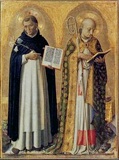
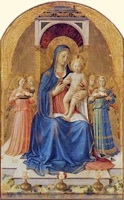
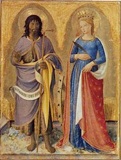
This polyptych was first documented in 1548 in a description of the Cappella di San Nicolò in San Domenico, which belonged to the Guidalotti family. This description noted that Elisabetta Guidalotti had decorated the chapel and identified Fra Angelico as the painter of the altarpiece. Elisabetta’s efforts in the chapel, and in particular the commission of an altarpiece from such a noted Florentine artist, were probably intended to help restore the prestige of her family after its disgrace following its part in the murder of Biordo Michelotti in 1398.
A 17th century document records that the altarpiece was commissioned in 1437, although modern art historians generally date it on stylistic grounds to the 1440s. The figure of St Nicholas of Bari seems to be a portrait of Pope Nicholas V. It has been suggested that Fra Angelico painted this polyptych in late 1447, en route from Orvieto for Rome.
The central panel of the polyptych depicts the Madonna and Child enthroned with angels. Four saints stand in fictive aedicules in two panels to the sides:
-
✴SS Dominic and Nicholas of Bari (identified as such on his stole) to the left; and
-
✴SS John the Baptist and Catherine of Alexandria (with her wheel) to the right.
The figures in these three main panels share a unified space behind the divisions imposed by the framing. This space has a natural appearance, despite the somewhat anachronistic gold background. It has been suggested that Fra Angelico was intent upon reconciling his own “modern” conception with his client’s desire for a sumptuous, albeit “old fashioned” appearance.
The other panels of the polyptych include:
-
✴two small panels (above the side panels of the main register) depicting the figures of the Annunciation;
-
✴six panels incorporated into each of the side pilasters depicting various saints; and
-
✴three predella panels, which depict scenes from the life of St Nicholas of Bari.
Although the chapel was undamaged when the vaults in the nave of San Domenico collapsed in 1614, the polyptych seems to have been removed soon after. The predella was displayed separately from the rest of the work by the early 18th century, when both parts were in the sacristy. Most of the panels escaped requisition in the Napoleonic period, but the predella panels were confiscated:
-
✴Dominique-Vivant Denon, the Director of the Musée Napoleon (later the Musée du Louvre) selected two of them in 1810, and they were duly shipped to Paris. Antonio Canova recovered them in 1815, when they were secured for the Pinacoteca Vaticana, Rome.
-
✴Agostino Tofanelli, the Director of the Musei Capitolini, Rome selected the third for this museum in 1812. It was returned to San Domenico in 1817.
The panels in San Domenico were moved to the Galleria Nazionale in 1860. They were assembled in a new frame in 1915, together with copies of the missing predella panels.
Read more:
W. Hood, “Fra Angelico at San Marco” (1993) New Haven
Return to Art in: Orvieto Perugia.
Return to “Foreign” Painters in Umbria.



